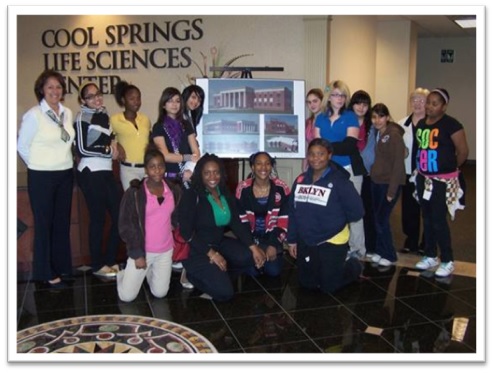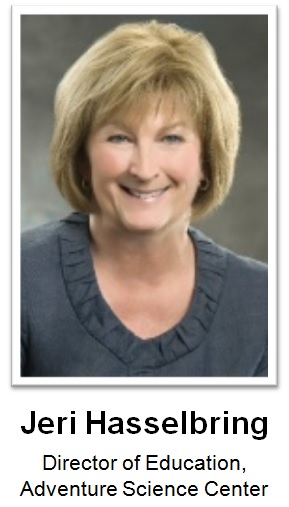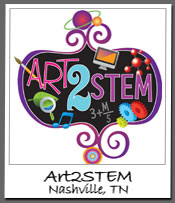Adventure Science Center’s mission is to ignite curiosity and inspire the lifelong discovery of science. To that end, the center annually engages more than 314,000 visitors of all ages and socio-economic backgrounds from throughout Tennessee and across the country with hands-on, interactive school and public programs; 44,000+ square feet of exhibits; and the renowned Sudekum Planetarium. The science center is an indispensable part of the science education community in Davidson County, as well as Middle Tennessee and the surrounding areas. POPULATION SERVED Art2STEM serves 100 7th and 8th grade girls from the following middle schools: - Issac Litton: 91% of students on Free/reduced lunch program, 58% minority.
- John Early Museum Magnet: 87% of students on Free/reduced lunch program, 89% minority.
- Thurgood Marshall: 81% of students on Free/reduced lunch program, 81% minority.
- West End: 47% of students on free/reduced lunch program, 52% minority.
PROGRAM FEATURES Art2STEM engages girls interested in art and design with STEM careers that include these interests over the course of a school year. By employing hands-on, informal education methodology, STEM mentoring, business site visits, interaction with professional women in STEM careers and the use of technology, participants develop a deep understanding of STEM career fields, broadening the student's perceived futures. Art2STEM clubs have approximately 20-25 participants and meet after school for two hours twice a month. Each club has two coaches and one or two volunteer mentors from STEM professions. Adventure Science Center’s program coordinator attends approximately one-half of the meetings of each club over the course of each semester. Coaches are provided professional development and a planning session at the start of each semester. Program options are outlined for use, as are suggested business site visits that complement the curriculum. Coaches may choose which curricular focus to pursue with their club. At the end of the first semester, Adventure Science Center hosts a Family Science Night for all club members, families, mentors, business partners and sponsors. Club participants showcase their projects while meeting girls from other schools.  | | Art2STEM visits a life-sciences focused research and development campus. | PARTNERS Art2STEM began in 2009 as a three-year grant awarded to Alignment Nashville by the National Science Foundation. The Pencil Foundation CEO served as the co-principal investigator and business engagement partner, recruiting businesses to host site visits. Adventure Science Center facilitated the program, designed and implemented the curriculum with the participating teachers, and built a network of professional STEM women for mentors. Deloitte and Women in Technology of Tennessee provided the most mentors. Tennessee Tech University trained teachers and mentors on software and technology used during the program. Belmont and Lipscomb universities provided housing and a venue for summer camp. FUNDING Art2STEM is funded privately by The Dan and Margaret Maddox Charitable Fund and Women in Technology of Tennessee. OUTCOMES Before Art2STEM was launched, Alignment Nashville staff gathered baseline data from Metro Nashville Public Schools of girls’ selection of STEM-related career academies. Only 2 percent of the girls in the schools targeted by Art2STEM were interested in choosing STEM-related academies. Over the first three years of presenting Art2STEM in the targeted schools, 46 percent of participating girls chose a STEM career academy when they progressed to high school. Additional data is collected by teachers and program staff to assess the change in attitude toward STEM-related careers and academies. These assessment tools include pre- and post- program surveys, creating a future life timeline, and drawing what an engineer looks like (pre- and post-program). For example, at the beginning of the program most students draw a man, but by the end of the program most students draw women in a wide array of STEM careers. Advice for Success  What feature of your program do you think has been most crucial for success? What feature of your program do you think has been most crucial for success?
Art2STEM is an opportunity for at-risk girls to meet women working in STEM professions that, for the most part, have never occurred to them. It broadens not only the vision of themselves, but also builds the “I can really do this” attitude. What were some of the challenges the program faced in its early stages? Initially it was difficult for teachers to step out of classroom mode and move into a more informal coaching role with the girls. Art2STEM is an inquiry-based program encouraging girls to problem solve, try, fail, and try again. Once the teachers felt comfortable in the role, the clubs flourished. We found that when grant funding was running out in year three and it looked as if that year’s girls would not be able to experience the week on a college campus, our business partners were willing to step up to the plate with funding. We secured a deep discount on room and board, got partners to “send a girl to camp,” and secured an in-kind donation from a bus line. What advice would you have for programs that want to integrate STEM? When integrating STEM into a program, remember to keep the material and activities fun, innovative, and—most importantly—relatable. | 









 What feature of your program do you think has been most crucial for success?
What feature of your program do you think has been most crucial for success?